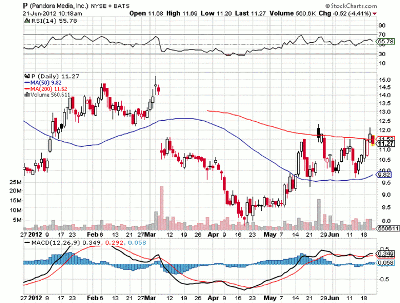Recent news has shares of Pandora Media (P) on the move, writes Beth Gaston of Schaeffer’s Research, and option traders are taking notice, as evidenced by this apparent straddle put on by one bullishly biased trader.
When one door closes for Pandora Media, Inc. (P), a window is opened. After an early drop this week due to Spotify’s competitive salvo (they will start streaming free music over the Internet), shares of Pandora fought back near breakeven in recent trading.
The Web-based music pioneer announced a seasonal deal with Chase Sapphire, a division of JPMorgan Chase & Co. (JPM). The pair is launching 14 summer-themed stations, including "Surf Rock," "Country BBQ," and "Hip Hop Road Trip," and the content kicks off this week with limited commercial interruption.
Although P is down roughly 25% from its June 14, 2011 IPO price and off 43% from its all-time high, the shares have been fighting back of late.
Since its April 18 all-time low, P has gained more than 50%, overtaking its 160-day moving average in the process. Now, the stock is beginning to fill its March 7 bear gap, which was spurred by an earnings-per-share miss.
All of the week’s excitement has stirred up some activity in Pandora’s option pits. On Thursday, call trading was twice as active as normal, while put volume is running slightly above average. In all, roughly 14,000 option contracts have traded, as compared to average daily volume of 10,000.
Two strikes seeing unusual attention is the out-of-the-money July 15 call and the deep-in-the-money July 15 put. More than 1,700 contracts have traded at each strike, and headed into Thursday’s trading, there were fewer than 800 open contracts. The calls have traded for $0.05 each, which is between the bid and the ask price. The puts have gone off for $3.60, which is closer to the bid price.
It’s possible this is a short straddle betting on limited volatility through the next month. This strategy would have breakevens set at $18.65 and $11.35, but would also have unlimited losses to the upside or downside. If this is the case, this trade has a definite bullish tilt, as the upside breakeven is considerably further from the stock’s current level.
The trader could also be trading a synthetic long spread by shorting the put and going long the call, although, again, the distance of the strike from the current stock price makes this an unusual strategy.
By Beth Gaston, contributor, Schaeffer’s Research


















